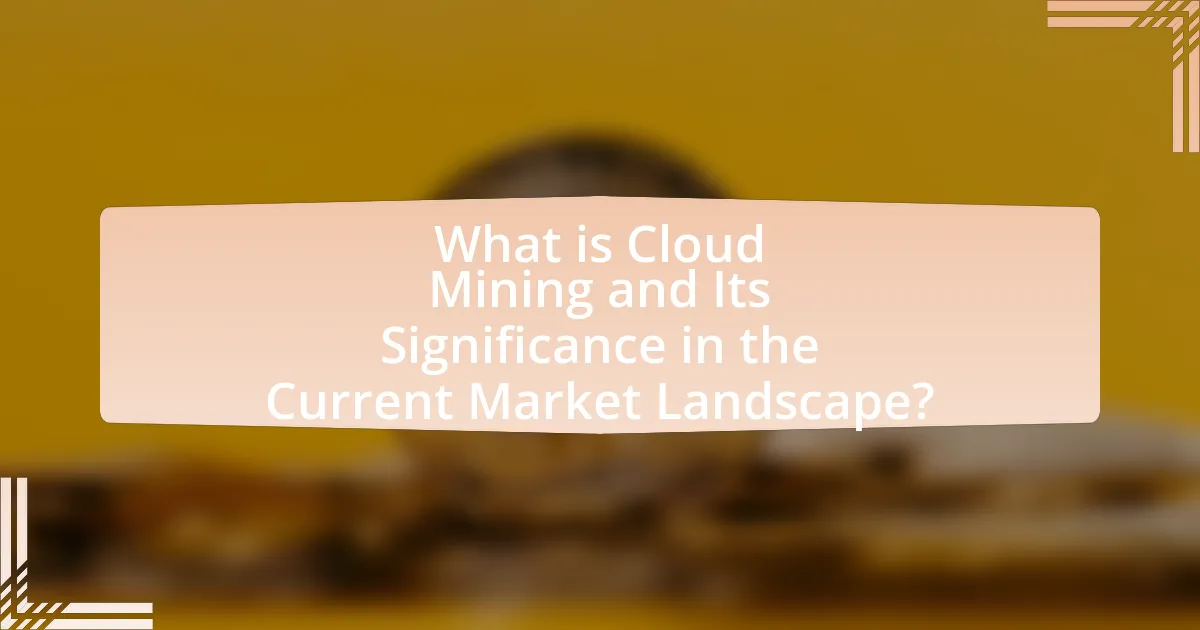Cloud mining is a method that enables individuals to mine cryptocurrencies remotely by renting computing power from third-party providers, thus bypassing the need for personal hardware and associated energy costs. This article evaluates the significance of cloud mining in the current market landscape, highlighting its role in democratizing access to cryptocurrency mining and its projected growth in 2023. Key components of cloud mining services, various operational models, advantages, challenges, and the impact of regulatory frameworks are discussed, along with future trends and innovations shaping the industry. Additionally, the article examines how cloud mining influences market dynamics, network security, and profitability, providing insights into best practices for users engaging in this evolving sector.

What is Cloud Mining and Its Significance in the Current Market Landscape?
Cloud mining is a process that allows individuals to mine cryptocurrencies remotely by renting computing power from a third-party provider, eliminating the need for personal hardware and energy costs. Its significance in the current market landscape lies in its accessibility, enabling users to participate in cryptocurrency mining without the technical complexities and financial barriers associated with traditional mining setups. As of 2023, the global cloud mining market is projected to grow significantly, driven by increasing interest in cryptocurrencies and the demand for efficient mining solutions, highlighting its role in democratizing access to blockchain technology and contributing to the overall growth of the cryptocurrency ecosystem.
How does Cloud Mining operate in the cryptocurrency ecosystem?
Cloud mining operates in the cryptocurrency ecosystem by allowing users to rent mining power from remote data centers instead of investing in physical mining hardware. This model enables individuals to participate in cryptocurrency mining without the need for significant upfront costs or technical expertise. Users purchase a contract from a cloud mining provider, which manages the mining equipment and processes the mining operations on behalf of the users. The profits generated from mining are then distributed to the users based on their contract terms. This approach has gained popularity due to its accessibility and the reduction of risks associated with hardware maintenance and electricity costs.
What are the key components of Cloud Mining services?
The key components of Cloud Mining services include hardware, software, mining pools, and contracts. Hardware refers to the physical machines used for mining, which are typically housed in data centers. Software encompasses the programs that manage mining operations and optimize performance. Mining pools are collaborative groups where miners combine their resources to increase the chances of earning rewards. Contracts are agreements between the service provider and the user, detailing the terms of service, fees, and expected returns. These components work together to facilitate efficient and scalable cryptocurrency mining without the need for individual users to manage physical equipment.
How do different Cloud Mining models compare?
Different cloud mining models, such as pay-per-use, subscription-based, and pooled mining, vary significantly in terms of cost, flexibility, and potential returns. Pay-per-use models charge users based on the actual computing power utilized, offering flexibility but potentially higher costs for sporadic use. Subscription-based models provide a fixed amount of hashing power for a set period, which can be more economical for consistent miners but may lack scalability. Pooled mining combines resources from multiple users to increase the chances of earning rewards, distributing profits based on contributed power, which can lead to more stable returns but may involve fees that reduce overall profitability. Each model has distinct advantages and disadvantages, influencing user choice based on individual mining goals and risk tolerance.
What are the advantages of using Cloud Mining?
Cloud mining offers several advantages, including reduced costs, accessibility, and convenience. Users can avoid the high upfront expenses associated with purchasing and maintaining mining hardware, as cloud mining services provide the necessary infrastructure. Additionally, cloud mining allows individuals to participate in cryptocurrency mining without requiring technical expertise or significant energy resources, making it accessible to a broader audience. According to a report by Statista, the global cloud mining market is projected to grow significantly, indicating increasing interest and adoption in this area.
How does Cloud Mining reduce entry barriers for new investors?
Cloud mining reduces entry barriers for new investors by eliminating the need for significant upfront capital investment in hardware and infrastructure. Traditional mining requires expensive equipment and ongoing maintenance costs, which can deter potential investors. In contrast, cloud mining allows individuals to rent mining power from remote data centers, enabling them to participate in cryptocurrency mining without the complexities of managing physical hardware. This model democratizes access to mining opportunities, as it typically requires only a small initial investment, making it accessible to a broader audience. Additionally, cloud mining services often provide user-friendly interfaces and support, further simplifying the process for newcomers.
What cost savings can users expect from Cloud Mining?
Users can expect significant cost savings from cloud mining primarily due to the elimination of hardware expenses and reduced electricity costs. By utilizing cloud mining services, users avoid the upfront investment in expensive mining equipment, which can range from hundreds to thousands of dollars. Additionally, cloud mining providers typically operate in regions with lower electricity costs, allowing users to benefit from reduced operational expenses. For instance, a study by the Cambridge Centre for Alternative Finance indicates that electricity costs can account for up to 60% of mining expenses, highlighting the financial advantage of outsourcing mining operations to specialized providers.
What challenges and risks are associated with Cloud Mining?
Cloud mining presents several challenges and risks, primarily including security vulnerabilities, lack of regulation, and potential for scams. Security vulnerabilities arise from the reliance on third-party providers, which can lead to data breaches and loss of funds. The lack of regulation in the cloud mining industry means that many operations may not adhere to legal standards, increasing the risk of fraud. Additionally, the potential for scams is significant, as some cloud mining services may promise unrealistic returns, leading investors to lose their capital. According to a report by the Federal Trade Commission, consumers have lost millions to cryptocurrency-related scams, highlighting the importance of due diligence when engaging in cloud mining activities.
How do market fluctuations impact Cloud Mining profitability?
Market fluctuations significantly impact Cloud Mining profitability by directly influencing cryptocurrency prices and mining difficulty levels. When cryptocurrency prices rise, the revenue generated from mining increases, enhancing profitability for cloud mining services. Conversely, during market downturns, lower cryptocurrency prices can lead to reduced earnings, making it challenging for cloud mining operations to cover their costs. For instance, a 2021 report indicated that Bitcoin’s price volatility resulted in a 50% change in mining profitability within a few months, demonstrating the sensitivity of cloud mining returns to market conditions. Additionally, fluctuations in mining difficulty, which adjusts based on the total network hash rate, can further affect profitability; as more miners enter the market during price surges, the difficulty increases, potentially reducing individual miners’ earnings.
What security concerns should users be aware of in Cloud Mining?
Users should be aware of several security concerns in cloud mining, including the risk of fraud, data breaches, and lack of regulatory oversight. Fraudulent cloud mining services can mislead users by promising high returns while failing to deliver any mining activity, resulting in financial losses. Data breaches pose a significant threat as sensitive user information, such as personal and financial data, can be compromised by cyberattacks. Additionally, the cloud mining industry often operates in a regulatory gray area, which can leave users without legal recourse in the event of a dispute or loss. These concerns highlight the importance of conducting thorough research and due diligence before engaging with cloud mining services.

How is Cloud Mining influencing the cryptocurrency market dynamics?
Cloud mining is influencing cryptocurrency market dynamics by lowering entry barriers for investors and increasing the overall hash rate of networks. This accessibility allows individuals without technical expertise or significant capital to participate in mining, thereby diversifying the participant base. As a result, the increased hash rate can enhance network security and stability, which positively impacts investor confidence. Furthermore, cloud mining services often offer competitive pricing and flexible contracts, leading to more efficient resource allocation in the market. According to a report by Statista, the global cloud mining market is projected to grow significantly, indicating its rising importance in the cryptocurrency ecosystem.
What role does Cloud Mining play in the decentralization of mining power?
Cloud mining facilitates the decentralization of mining power by allowing individuals to participate in cryptocurrency mining without the need for expensive hardware or technical expertise. This model enables users to rent mining power from remote data centers, thereby lowering the barrier to entry and distributing mining capabilities across a broader range of participants. As a result, cloud mining reduces the concentration of mining power in the hands of a few large entities, promoting a more equitable and decentralized network. According to a report by the Cambridge Centre for Alternative Finance, decentralized mining is essential for maintaining the integrity and security of blockchain networks, as it prevents any single entity from gaining excessive control.
How does Cloud Mining affect the overall network security of cryptocurrencies?
Cloud mining can negatively impact the overall network security of cryptocurrencies by centralizing mining power in the hands of a few service providers. This centralization increases the risk of a 51% attack, where a single entity gains control over the majority of the network’s hashing power, potentially allowing them to manipulate transactions and double-spend coins. For instance, in 2018, the Bitcoin Gold network suffered a 51% attack attributed to centralized mining pools, demonstrating how cloud mining can compromise security. Additionally, reliance on cloud mining services can lead to vulnerabilities, as users must trust these providers to operate honestly and securely, which is not always guaranteed.
What impact does Cloud Mining have on mining difficulty and rewards?
Cloud mining generally lowers mining difficulty and affects rewards by increasing the overall hash rate in the network. As more participants engage in cloud mining, the total computational power dedicated to mining rises, which can lead to adjustments in mining difficulty according to the network’s algorithm. For instance, Bitcoin’s mining difficulty adjusts approximately every two weeks based on the total hash rate, meaning that as cloud mining operations expand, the difficulty can increase, making it harder for individual miners to earn rewards. This dynamic can dilute the rewards for existing miners, as the total number of miners competing for the same block rewards increases.
How are regulatory frameworks shaping the Cloud Mining landscape?
Regulatory frameworks are significantly shaping the Cloud Mining landscape by establishing legal standards that govern operations, ensuring compliance, and promoting transparency. For instance, regulations in countries like the United States and the European Union require cloud mining services to adhere to anti-money laundering (AML) and know your customer (KYC) protocols, which enhances accountability and reduces fraud risks. Additionally, regulatory bodies are increasingly focusing on environmental impacts, leading to stricter guidelines on energy consumption and sustainability practices in cloud mining operations. This regulatory scrutiny influences market dynamics by encouraging responsible practices and fostering consumer trust, ultimately shaping the competitive landscape of cloud mining providers.
What are the current regulations affecting Cloud Mining operations?
Current regulations affecting cloud mining operations vary by jurisdiction but generally include compliance with financial regulations, anti-money laundering (AML) laws, and taxation requirements. For instance, in the United States, cloud mining services must adhere to the Financial Crimes Enforcement Network (FinCEN) guidelines, which classify them as money services businesses (MSBs) and require registration and reporting of transactions. Additionally, countries like China have imposed strict bans on cryptocurrency mining, impacting cloud mining operations significantly. In the European Union, regulations are evolving, with the proposed Markets in Crypto-Assets (MiCA) framework aiming to provide a comprehensive regulatory approach to digital assets, including cloud mining. These regulations are designed to ensure consumer protection, financial stability, and the prevention of illicit activities within the cryptocurrency ecosystem.
How do different countries approach Cloud Mining legislation?
Different countries approach cloud mining legislation with varying degrees of regulation and oversight. For instance, the United States has a relatively permissive stance, allowing cloud mining operations to flourish under existing cryptocurrency regulations, while emphasizing compliance with anti-money laundering (AML) and know-your-customer (KYC) laws. In contrast, China has imposed strict bans on all cryptocurrency mining activities, including cloud mining, citing environmental concerns and financial risks. Meanwhile, countries like Canada and Germany have adopted a more balanced approach, implementing regulations that promote innovation while ensuring consumer protection and environmental sustainability. These legislative frameworks reflect each country’s economic priorities and regulatory philosophies regarding cryptocurrency and cloud mining activities.

What are the future trends and innovations in Cloud Mining?
Future trends and innovations in cloud mining include the integration of artificial intelligence for optimized mining operations and the adoption of renewable energy sources to enhance sustainability. AI algorithms can analyze market trends and adjust mining strategies in real-time, improving efficiency and profitability. Additionally, as environmental concerns grow, cloud mining services are increasingly utilizing solar and wind energy, which can reduce operational costs and appeal to eco-conscious investors. According to a report by the International Energy Agency, the shift towards renewable energy in cryptocurrency mining is expected to rise significantly, indicating a strong trend towards sustainable practices in the industry.
How is technology evolving to enhance Cloud Mining services?
Technology is evolving to enhance Cloud Mining services through advancements in hardware efficiency, software optimization, and the integration of artificial intelligence. Improved hardware, such as ASIC miners, increases processing power while reducing energy consumption, leading to more profitable mining operations. Software innovations, including better algorithms for mining pools and enhanced user interfaces, streamline the mining process and improve user experience. Additionally, artificial intelligence is being utilized to predict market trends and optimize mining strategies, allowing users to maximize their returns. These technological advancements collectively contribute to a more efficient and user-friendly Cloud Mining environment.
What advancements in hardware are influencing Cloud Mining efficiency?
Advancements in hardware such as ASIC miners, improved GPU technology, and enhanced cooling systems are significantly influencing cloud mining efficiency. ASIC miners, specifically designed for cryptocurrency mining, offer higher hash rates and energy efficiency compared to traditional hardware, leading to increased profitability. Improved GPU technology allows for better performance in mining algorithms, enabling cloud mining services to process transactions more rapidly. Additionally, enhanced cooling systems reduce operational costs by maintaining optimal temperatures, which prolongs hardware lifespan and efficiency. These advancements collectively contribute to a more effective and profitable cloud mining environment.
How are software solutions improving user experience in Cloud Mining?
Software solutions are enhancing user experience in cloud mining by providing intuitive interfaces, real-time analytics, and automated management tools. These features allow users to easily monitor their mining operations, optimize performance, and make informed decisions based on data-driven insights. For instance, platforms like NiceHash and Genesis Mining offer user-friendly dashboards that simplify the process of selecting mining pools and tracking profitability, which significantly reduces the complexity often associated with cloud mining. Additionally, automated tools help users manage their mining rigs more efficiently, minimizing downtime and maximizing returns.
What best practices should users follow when engaging in Cloud Mining?
Users engaging in cloud mining should prioritize selecting reputable service providers to ensure security and reliability. Reputable providers typically have transparent operations, positive user reviews, and established track records, which mitigate risks associated with scams and fraud. Additionally, users should conduct thorough research on the profitability of the mining contracts offered, as profitability can vary significantly based on factors such as cryptocurrency market trends and operational costs. Furthermore, users should regularly monitor their mining performance and adjust their strategies accordingly to maximize returns. According to a report by the Cambridge Centre for Alternative Finance, understanding the underlying technology and market dynamics is crucial for making informed decisions in cloud mining.
How can users select the most reliable Cloud Mining provider?
Users can select the most reliable Cloud Mining provider by evaluating key factors such as transparency, user reviews, and the provider’s operational history. Transparency is crucial; reputable providers openly share their mining operations, including hardware details and location. User reviews on independent platforms can reveal the experiences of others, highlighting potential issues or confirming reliability. Additionally, examining the operational history of a provider, including how long they have been in business and their track record of payouts, can indicate stability and trustworthiness. For instance, providers with a longer history and consistent positive feedback are often more reliable than newer or less-reviewed options.
What strategies can maximize returns from Cloud Mining investments?
To maximize returns from cloud mining investments, investors should focus on selecting reputable cloud mining providers, optimizing contract terms, and diversifying their mining portfolios. Reputable providers often have a proven track record, transparent operations, and competitive pricing, which can lead to higher profitability. Optimizing contract terms, such as choosing contracts with favorable electricity rates and minimal maintenance fees, can significantly enhance net returns. Diversifying across different cryptocurrencies and mining contracts reduces risk and increases the potential for higher overall returns, as different assets may perform variably in market conditions. According to a study by the Cambridge Centre for Alternative Finance, the profitability of cloud mining can be influenced by factors such as mining difficulty and cryptocurrency market trends, underscoring the importance of strategic selection and management in maximizing returns.